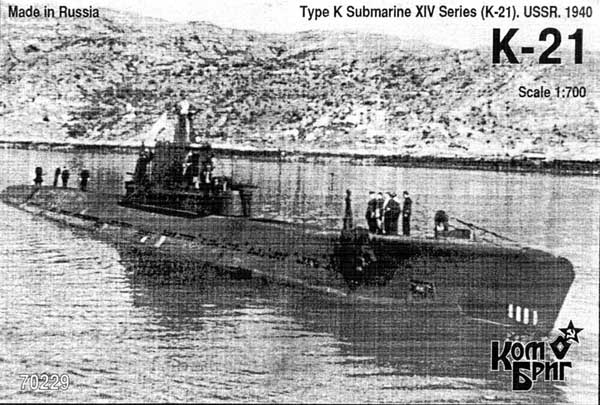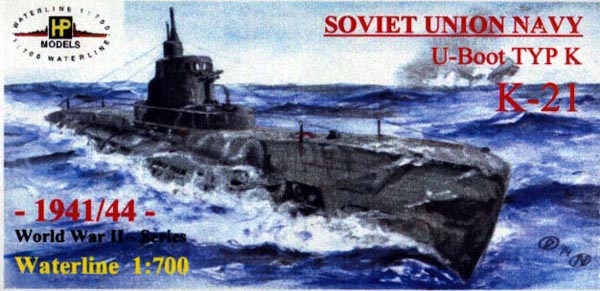| History
Design of these submarines started in 1934 when navy issued a specification
for the cruiser type submarine that would be able to work with the fleet.
The initial design was confirmed in April 1935 and the project was given
number 41 or Series XIV. Design was complete by the end of next year
and first three submarines were laid down in December 1936. A grand
total of 62 submarines of this class were planned but as with many other
ships in the Soviet naval program of the time that number was wildly optimistic
and it was later cut to 20. In the end only 12 were laid down between
1936 and 1938 of which 11 were completed.
K class submarines were the best Soviet submarines of the war and their
characteristics were comparable to large submarines built abroad.
Their characteristics are as follows:
Displacement: 1500/2117 tons
Dimensions: 97.7 m oa x 7.4 m x 4.04 m
Reserve Buoyancy: 41.4%
Machinery: two 9DKR diesel engines, 8400bhp = 22 knots; one 38K8 diesel
generator, 800bhp; two PG-II electric motors, 2400 shp = 10.3 knots
Bunkerage: 46 tons oil normal, 240 tons oil full; surfaced, 2400nm
at 22 knots, 16,500nm at 9 knots; submerged, 10.4nm at 10.3 knots, 175nm
at 2.9 knots
Endurance: 30 days normal, 50 days max
Diving Depth: 80 meters normal, 100 meters full
Dive Time: 50 seconds surfaced to periscope depth, 30 seconds decks
awash to periscope depth
Max Underwater Time: 72 hours
Guns: two 100mm/51 B-24-PL (400 rounds total), two 45mm/46 21-K AA
(1100 rounds total), two 7.62mm mgs.
Torpedo Tubes: 533mm, six bow + two stern + two external aft; twenty-four
torpedoes
Mines: 20 EhP-36 mines
Sonars: from 1939 Mars-12 hydrophones, from 1942 on Lend-Lease Drakon-129
Complement: 62-65
6 submarines (K-1, K-2, K-3 and K-21, K-22, K-23) were completed before
the war, and were transferred to the Northern fleet. Two more (K-51
and K-52) were completed with emergency measures in September-November
1941, and were given to the fleet without even acceptance trials.
Last four were being slowly completed during the war in blockaded Leningrad.
Three (K-53, K-55 and K-56) were completed in 1942-44 while K-54 was never
completed. The boats completed during the war remained in the Baltic
sea throughout the war.
These large boats had only limited success during the war since the
nature of the war forced them to operate in the nature they were not designed
for - in the coastal areas of the north and in the relatively small Baltic
Sea where their large size and relatively slow dive times put them at a
disadvantage. During the war K boats confirmed to have sunk 5 transports
and 2 warships while damaging several more, in addition several other transports
were claimed to have sunk, but non have been confirmed. In addition
Soviet sources credit them with 11 transports and 3 warships sunk but their
mines. The exact number of the ships sunk by Soviet submarines is
still a mystery since there are no comprehensive mistake free sources that
allow the numbers to be confirmed.
The most famous (and infamous) attack by these boats was made by K-21
on 5th of July 1942 against German Battleship Tirpitz. For the next
40 years Soviet literature claimed that K-21 hit it and forced the German
battleship to retire back to the harbor. Unfortunately German sources
do not confirm that, more so they didn’t even notice that they were attacked!
What most likely happened is that K-21 did indeed attack Tirpitz, but missed
and the explosions that were heard by K-21’s crew were the sound of the
propellers of the German ships maneuvering.
During the war 5 of the subs were lost to the Germans (K-1 - lost to
causes unknown in Sept 1943, K-2 lost on a minefield in October 1942, K-3
sunk by German Submarine hunters in March 1943, K-22 lost to causes unknown
in February 1943, K-23 lost to German Submarine Hunters or Aircraft in
May 1942). After the war these subs were the longest ranging sub
in Soviet inventory for several years until new post war designs were built
and were left in service until the end of 1950s. K-21 was partially
restored and today can be seen in Severomorsk near Murmansk. |
| Models
Hulls
For a long time HP models K-21 was the only game in town if you wanted
a K-21 in any scale. Fortunately recently Kombrig came out with their
own version of K-21. Looking at the HP hull first thing you notice
is that is it completely smooth with no flood holes. That is unfortunate
since K class subs had a large number of flood holes in its hull.
Kombrig hull does have those in abundance. Putting the hulls side
by side other discrepancies become noticeable. HP hull is 2mm longer
than the Kombrig hull. After measuring them Kombrig hull is spot
on (overall length is 13.9 mm while the real boat’s 97.7 meters divided
by 700 comes out to 13.95mm). It seems that HP used the boat’s overall
length as its waterline length, since the HP hull is 13.9mm along its waterline.
Second thing that is immediately seen is the difference in the bow between
those two models. Kombrig hull has the characteristic triangle shape
and a slight hump seen on the early K boats, while it is absent on the
HP hull. As a warning, several of the later submarines (probably
K-51 and up) were completed with a much larger hump on the bow to improve
sea keeping, so refer to the references if you are planning to build any
boat other than K-21. There are several other differences between
the hulls. The HP’s desk is wider and the walkway around the superstructure
is loner and more square, while Kombrig’s is a lot more proportionate and
seems to better fit the photo evidence. Overall Kobmrig hull beats
HP’s hands down. In addition to the waterline hull Kombrig kit (like
their other submarine kits) offers a choice of a full hull or waterline
version. It is beautifully done and recreated the complex shape of
the K boat’s hull. |
click images
to enlarge
|
| Details
Here the difference between kits becomes even more pronounced.
HP kit has only 9 parts which are rather poorly cast, while Kombrig has
24 excellently cast parts. All of the rudders and other things that
are necessary to build a full hull version of the sub are included in the
Kombrig’s kit. Artillery is also excellently cast, while HP’s guns
are nearly unusable. HP’s superstructure is good 2mm longer than
Kombrig’s one and looking at the photos, it would seem that Kombrig is
more accurate. Also gun turrets are identical in the HP kit while
Kombrig includes more streamlined aft turret, which is more accurate.
The only problem that I saw with the Kombrig’s superstructure is the absence
of the rounded extensions where the aft 45mm gun would be on the superstructure,
but it is a very minor detail. Overall Kombrig once again wins without
a question. |
 |




